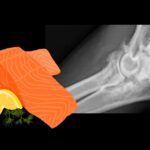New findings from looking at the eating habits of thousands of dogs are giving us a glimpse into the powerful effects of calorie restriction and intermittent fasting—techniques for health and longevity that we have known about in humans for decades.
We have known for at least 75 years that reducing calories in animals and people leads to a longer, healthier life.
My favorite study of all time (yes, I am that much of a nerd that I have a favorite scientific study) followed 48 Labrador Retrievers for their entire lives. They split the dogs into two groups. One group was fed a normal controlled amount and the other was fed 25% less.
The calorie restricted Labs lived on average almost 2 years more.
That is a huge difference in a pet whose average lifespan is only 12 years.
But that wasn’t the only difference.
The leaner dogs got less osteoarthritis (OA) of the hip and shoulder. And if they got OA, they got it later in life and less severely.
The difference in OA development between lean and traditionally fed Labs was dramatic. At age 8, hip joint OA was present in:
- 68% (15/22) of regularly fed Labs
- Only 14% (3/21) of diet-restricted Labs
Even more striking was the delayed onset of hip arthritis—median age of diagnosis for the diet-restricted dogs was age 12, versus 6 years old for regularly fed dogs. Imagine saving your pet 6 years of arthritis pain with one simple change.
Shoulder joint OA followed a similar pattern, though with higher rates in both groups of dogs at age 8:
- 86% (19/22) of regularly fed Labs showed shoulder OA
- 57% (12/21) of diet-restricted Labs were affected

Osteoarthritis is a very common debilitating disease of dogs and cats, causing:
- Pain and chronic inflammation, affecting many body systems
- Poor quality of life for pets
- Euthanasia
- Expense for owners: X-rays, lifelong medications with monitoring requirements, supplements and special diets, sometimes surgical treatments
- Heartache for pet parents, watching their aging pets struggle to do things they used to love doing

In my years of practice, I’ve treated countless pets with painful joints and have watched my own pets transform from happy, bounding athletes to stiffly and slowly rising from the bed to go for our walks. I’ve had countless difficult and teary-eyed conversations in the exam room, always circling back to that dreaded question: ‘when is it time, doc?’.
We must prevent or delay this disease whenever possible – because while we can manage arthritis, we cannot cure it.
If you need guidance to figure out if your pet is lean or chubby, check out my guide on body condition scoring and talk to your vet for a hands-on assessment.
Pet parents consistently see their pets as leaner than they actually are, so get an expert second opinion!
Dog Aging Project Findings
The amount of calories fed is just one piece of the puzzle that impacts nutrition and longevity science. We can also look at what our pets eat, when they eat it and how often.
The Dog Aging Project is an ambitious multi-year, 40,000 dog study. Researchers are following client-owned dogs throughout their lives, noting things like activity levels, diseases, lifespan, and feeding patterns. The study is still ongoing, but a preliminary report was just released.
Using information from 24,000 dogs, the researchers found an association between how often the dogs were fed and the diseases they had at that time. They do not have data for the amount of calories fed, or the body condition of the dogs, so the conclusions we can draw from this are limited.
Dogs that are fed once a day have:
- Lower cognitive dysfunction scores (lower score means better brain function)
- 59% lower odds of liver/pancreas disorders
- 35% lower odds of gastrointestinal issues
- 29% lower odds of kidney/urinary problems
- 22% lower odds of orthopedic conditions
The difference in brain function scores between once-daily fed and multiple-fed dogs was roughly equivalent to the cognitive difference typically seen between a 7-year-old dog and an 11-year-old dog.
Wow! That’s huge!

While these initial results from the Dog Aging Project are exciting, they come from a cross-sectional study—meaning they show associations between feeding frequency and health at one point in time, but they do not prove the feeding frequency causes the lower disease rates. The project will continue following these dogs over many years, which will help determine if feeding frequency can actually cause improved health outcomes.
Does it matter what we feed?
Of course.
While a detailed discussion of pet nutrition would fill several newsletters, one key finding stands out when it comes to fasting: diet composition matters. Research shows that what we feed can significantly affect how well our pets handle periods without food.
A fascinating study in healthy dogs demonstrated this clearly. Dogs fasting after eating a low-fat diet showed decreased immune function. However, when the same dogs fasted after eating a diet rich in healthy fats and MCTs (medium-chain triglycerides- a source of ketones), their immune function stayed strong.
This suggests that the food we choose to feed during eating periods can significantly impact how well our pets handle fasting periods – with higher fat diets appearing to offer protective benefits, at least for the immune system.
A more recent study on dogs fed quite high fat levels (55%, mostly pork lard) found that this diet led to metabolic dysfunction, similar to that seen with aging. This was not a study of fasting.
I think it is clear that we are entering an exciting time when science is going to be showing us more and more about the ideal diet and feeding strategy for pets.
Beyond Pets: The Bigger Picture
To better understand how feeding frequency affects health, we can examine research from both lab animals and human studies. Intermittent fasting (IF) and Time Restricted Eating (TRE) are becoming more mainstream by the year and there are hundreds more published studies in people, compared to pets.
The balance of studies show benefits, though it can be very difficult to separate the benefits of IF and TRE from pure calorie restriction, because fasting will usually lead to eating less calories.
The Science of Fasting in Humans
A 2024 review of 157 studies revealed compelling benefits across multiple body systems.
In short—a longer life, a leaner body, and a sharper mind.
Key findings include:
- Improved Metabolism: Better blood sugar control and reduced body fat
- Heart Health: Lower blood pressure and improved cardiovascular markers
- Brain Function: Enhanced memory and potential protection against age-related decline
- Cellular Health: Activated cellular cleaning processes and reduced inflammation
- Disease Prevention: Possible delayed onset of age-related diseases
The researchers note that “no single pharmaceutical medication can provide such a wide spectrum of benefits on metabolic health as IF”.
Does every study show a benefit?
Good golly, no!
In fact, the American Heart Association recently released a report that looked at data from 20,000 people and found those people restricting eating to an 8 hour window were more likely to die from heart disease.
It was a cross-sectional study with self-reported data, like the Dog Aging Project study, and so they do not present information about calorie consumption or obesity. A quote from one of the researchers highlights the limitations of the study: “It needs to be emphasized that categorization into the different windows of time-restricted eating was determined on the basis of just two days of dietary intake.”
One study showed no long term weight loss benefit for time restricted eating versus calorie restriction alone.
Both human and pet research in this area is still emerging, with many questions yet to be answered.
While this newsletter focuses on pet health, if you’re interested in exploring intermittent fasting for yourself, start with trusted medical resources and speak with your healthcare provider. Fasting isn’t appropriate for everyone, and proper medical guidance is essential.
What about cats?
The research on fasting in cats is limited, but intriguing:
- In one small study, cats fed once daily showed better satiety (less hunger) and ate less overall
- Another study found that restricted feeding times only led to sustained weight loss when combined with low-calorie food
Cat nutrition deserves its own deep dive—these carnivores often live indoors eating high-carb diets, far from their evolutionary norms. Stay tuned for a future newsletter exploring the fascinating world of feline nutrition!

What does this mean for your pet?
Top Priority- Lean Pet!

Solid evidence tells us how important this is for longevity and preventing disease.
But how do we do it?
Recognizing, preventing and treating obesity in pets isn’t easy. Don’t attempt to do it alone.
That is the #1 cause of failure.
Where to start:
- Read my guide on where to start with weight loss and assessing body condition score (BCS)
- Consult your vet, as they can help you get an accurate BCS, weight, and help design a diet plan based on your pet’s unique situation
To Fast Or Not To Fast , That Is The Question…
The evidence is promising, but preliminary.
In veterinary medicine, we frequently lag behind human research, and vets must often make recommendations based on the best available evidence.
The risk of waiting for perfect evidence?
We miss opportunities to prevent disease in pets who could benefit today.
The science of feeding frequency suggests enough potential benefits to warrant thoughtful consideration.
If you’re interested in exploring different feeding patterns for your pet:
- Start with a vet check and discussion about your pet’s age, health and lifestyle
- Ensure proper nutrition
- Make any changes gradually, monitoring your pet’s response
- Monitor and track changes in weight, appetite, energy and general well-being
Remember: What works for one pet may not work for another. Work with your veterinarian to develop an individualized feeding plan that best serves your pet’s needs.





